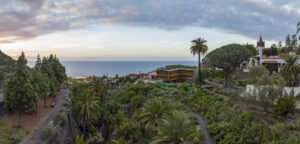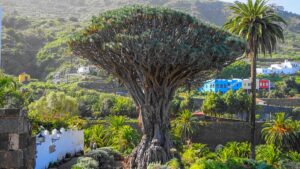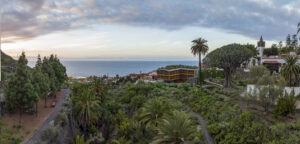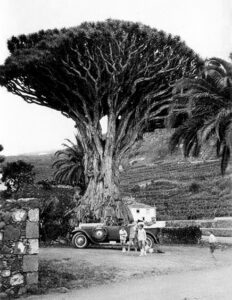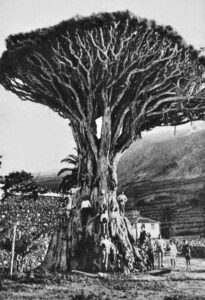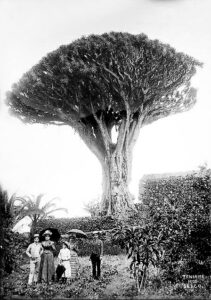El Parque del Drago
Datos técnicos:
Arquitectos: Fernando Menis, Felipe Artengo Rufino, José Maria Rodriguez Pastrana.
Emplazamiento: Icod de los Vinos. Tenerife. España
Programa: Paisajístico
Estructura: Acero
Cliente: Dirección General de Medio Ambiente.
Estado: Obra construida 1995.
Premios: 1er Premio, Concurso Internacional de Arquitectura.
Descripción: Este es un proyecto de rehabilitación de un paisaje que había sido degradado con la excusa de lograr un malentendido progreso que había abusado de la naturaleza. El Drago, Dracaena Drago, es una especie arbórea endémica de las Islas Canarias, cuyo lento crecimiento la hace comparable a los baobabs. El espectacular ejemplar de Icod de los Vinos es el más antiguo de los que se conservan en el archipiélago atlántico. Conocido como el árbol milenario, tiene una forma estructural similar en su arquitectura a los monstruos de varias cabezas. Bebiendo de la tradición romana del Jardín de las Hespérides, los estudiosos a lo largo de la historia han logrado transmitir el aura mitológica y primitiva de los dragones a este tipo de vida vegetal y actualmente es conocido popularmente como el Dragón de Canarias, que cuida y protege a las islas.
El Drago de Icod nació al borde del barranco conocido como El Río y en la actualidad se encuentra arropado del viento por las casas de la propia “Ciudad del Drago”. El árbol mide más de 16 metros de altura y posee una base de unos 20 metros de circunferencia. El entorno de esta maravilla vegetal ha sufrido muchas transformaciones: deforestado su entorno termófilo pasó a ser un habitante más de la tierra de cultivo y, quizás, pasto, y más tarde formó parte de una finca dedicada a las plataneras. Su primera protección fue un muro de piedras; luego, un vallado bajo, coincidiendo con la carretera que, hasta 1993, pasó demasiado cerca de su base. Las raíces se vieron seriamente perjudicadas por la carretera y por la inadecuada flora (rosas que requerían mucha más agua que el drago). Además, el drago resultaba demasiado accesible, llegando a ser en ocasiones víctima de actos vandálicos –fueron los peores años.
El proyecto de Fernando Menis, junto a sus ex socios, ganador de un concurso en 1984 para la ordenación del entorno del árbol, proponía recuperar la naturaleza primigenia del lugar, liberando ambos lados del barranco por donde giraba la antigua carretera y repoblando los terrenos del parque con primitivas especies autóctonas en las cotas donde crecen naturalmente. Sobre esta base el proyecto trazó las veredas óptimas para recorrer el conjunto alrededor del monumental árbol. El parque incorpora el trazado del antiguo callejón del Molino, descubierto al demoler una construcción de los años cuarenta del siglo XX. El antiguo callejón articula ahora la entrada al parque y al centro de visitantes que complementa e ilustra el recorrido por el jardín y que se desarrolla en un gran espacio enterrado al que se accede a través de una rampa en espiral. Sobre la superficie emerge una construcción de proporciones similares a las vecinas casonas históricas.
El jardín temático creado alrededor del Drago se basó por un lado en la recuperación de los muros de sorriba y de las acequias, especialmente del gran muro que le separaba históricamente de la ciudad, que ahora es el límite con la trama urbana, puesto que representaban una colonización tradicional del territorio estrechamente ligada al valor paisajístico del barranco, y por otro, ayudaban a aislar el Drago de la contaminación a la vez que colaboraban en la devolución al entorno más inmediato del drago a su primitiva condición de ladera hacia el cauce.
El Parque se encuentra zonificado en unidades que representan la vegetación potencial del territorio sobre la base de la naturaleza bioclimática de esa zona de la isla de Tenerife. Es un ejemplo de jardín sostenible diseñado para el aprendizaje de la flora y la vegetación del entorno, ya que las especies se encuentran rotuladas con sus nombres científicos y vulgar. Por otro lado es también una nueva apuesta de los arquitectos por una geometría libre, adaptada a la topografía, de la tipología jardín inglés. Topografía que solo se modifica y ajusta para definir espacios y recorridos con pendientes accesibles a todo tipo de usuarios, llenos de sorpresas y experiencias sensoriales, manteniendo algunas preexistencias históricas. También es un espacio para el ocio y disfrute de su entorno ajardinado. A los pies del Drago se creó una zona dedicada a los dragos más pequeños, denominada «Guardería de Dragos». En ella se muestra el proceso evolutivo de esta especie.
El árbol, recuperado su entorno natural inicial, ha vuelto ahora, a pesar de su avanzada edad, a la plenitud de su follaje. El tronco se ha recuperado lanzando nuevas raíces y la flora del lugar ha recuperado su espacio. En torno al drago milenario se disfruta hoy de su actual parque de tres hectáreas de extensión que exhibe ya, tras más de 20 años de normalidad natural, una frondosa representación de la flora canaria más espléndida (cardones, tabaibas, hayas, brezos, palmeras, otros dragos, aceviños, viñátigos, tilos, laureles, etc.), siendo un jardín botánico de enorme valor biológico.
Los estudios de estabilidad practicados en 1995 (Universidad de Stuttgart) y un estudio dieléctrico –una especie de electro para corroborar partes vivas y muertas– realizado en 2011 (Consejo Superior de Investigaciones Científicas, CSIC) auguran todavía mucha estabilidad y salud.

